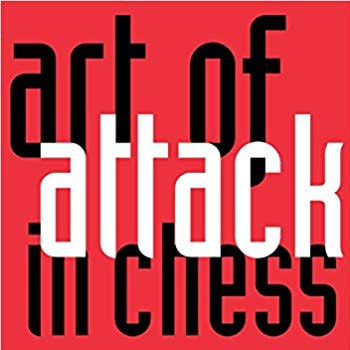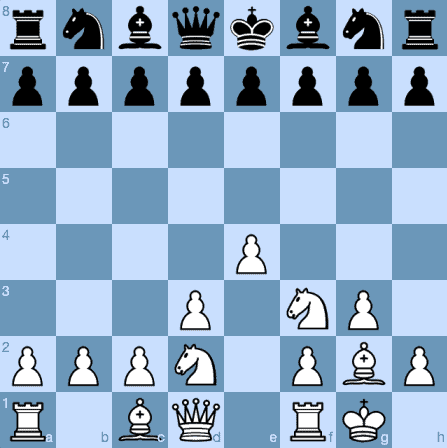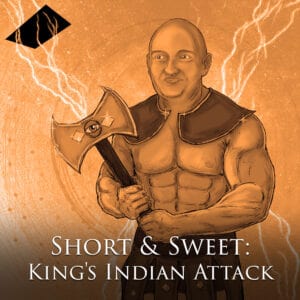What is the King’s Indian Attack?
The King’s Indian Attack (sometimes shortened to ‘KIA’ in chess literature) is an opening for White in which the first player utilises a popular black defense, but with an extra move.
The King’s Indian Defense typically arises after the moves:
1.d4 Nf6
2.c4 g6
3.Nc3 Bg7
4.e4 d6
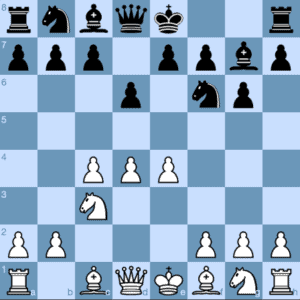
The King’s Indian Defense
Black will castle on the kingside and will often play for a kingside attack with …e5, …f5 and, in some lines, with …g5 and …h5 too.
The King’s Indian Attack aims to make use of the extra move granted to White, thus enabling the first player to set up their position of choice. This usually involves an early e2-e4, with White heading for this structure against most of Black’s replies.
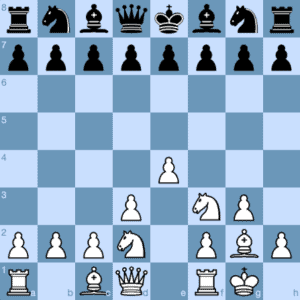
A Typical King’s Indian Attack Scenario for White
The King’s Indian Attack is an opening system rather than a specific set of moves. The main battle is deferred until the late middlegame.
Flexibility
Flexibility is one of the big advantages of playing the King’s Indian Attack. It can be reached via many different mover orders, including: 1.e4, 1.Nf3, 1.g3 and even 1.d3. Both players also need to be aware of transpositions to and from other openings.
For example, fans of the French Defense may find themselves facing a King’s Indian Attack after 1.e4 e6 2.d3. White’s second move looks passive, especially when compared to the much more common 2.d4. However, if White is happy with the King’s Indian Attack then it is clear to see that two moves from the scenario depicted above are already on the board.
This anti-French strategy was extremely powerful in the hands of Bobby Fischer, the 11th World Champion, who used it as an occasional alternative to his usual 1.e4 e6 2.d4 d5 3.Nc3. Incidentally, Fischer was a leading exponent of the King’s Indian Defense as Black and in his youth he liked to play 1.Nf3 with White to reach his favorite set up.
Who Plays the King’s Indian Attack?
Bobby Fischer, as already mentioned, was an expert in the system, even though he only used it sparingly. Tigran Petrosian, the ninth World Champion, and David Bronstein, challenger for the title in 1951, also used the opening to great effect.
Plans in Action
Given the extreme flexibility of the King’s Indian Attack, it is not such a simple task to present a summary of the plans available to both sides. White often attacks on the kingside, with all guns blazing, while Black rushes to create counter-play on the queenside, although that is just the tip of the iceberg as far as the respective plans go.
The three illustrative games provide an indication of the plans in action.
Bronstein the Bamboozler
In the first game, David Bronstein manages to bamboozle a renowned expert in the French Defense to score a remarkably quick victory. It is extraordinary how tactical opportunities can appear so quickly in an opening noted for its slow build-up.
Petrosian’s Queen Sacrifice
In this game, Petrosian adopts a different strategy and it looks to be heading for a typical game of steady manoeuvring, typical of the great champion’s style. However, Petrosian slyly set up a magnificent queen sacrifice, which resulted in a forced checkmate.
Fischer’s Most Famous King’s Indian Attack
This is Fischer’s most famous game with the King’s Indian Attack. His idea of putting the brakes on Black’s queenside play with 13.a3! was revolutionary at the time. Once again, we see a wonderfully tactical finish to the game.
Chessable Course
Our new Chessable course on the King’s Indian Attack, by FIDE Master Kamil Plichta, is now available.
There is also a Short & Sweet version of the course, which can be found here.
More Chess Opening Basics
Here are links to the other parts of our series on Chess Opening Basics. More openings will be added soon.
King’s Pawn Openings
Berlin Defense, Rio de Janeiro Variation
Sicilian Najdorf, Poisoned Pawn Variation
Queen’s Pawn Openings
Others
